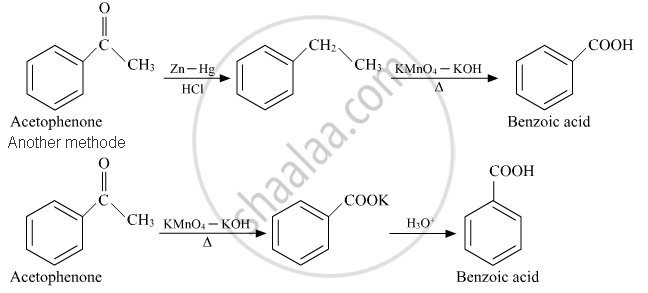Advertisements
Advertisements
प्रश्न
How will you convert the following in not more than two steps:
Acetophenone to Benzoic acid
उत्तर
Acetophenone to Benzoic acid

APPEARS IN
संबंधित प्रश्न
Derive van’t Hoff general solution equation
3.9 g of benzoic acid dissolved in 49 g of benzene shows a depression in freezing point of 1.62 K. Calculate the van't Hoff factor and predict the nature of solute (associated or dissociated).
(Given : Molar mass of benzoic acid = 122 g mol−1, Kf for benzene = 4.9 K kg mol−1)
Calculate the amount of benzoic acid (C6H5COOH) required for preparing 250 mL of 0.15 M solution in methanol.
How van’t Hoff factor is related to the degree of dissociation?
The van’t Hoff factor (i) accounts for ____________.
The values of Van’t Hoff factors for KCl, NaCl and K2SO4, respectively, are ______.
Van’t Hoff factor i is given by the expression:
(i) i = `"Normal molar mass"/"Abnormal molar mass"`
(ii) i = `"Abnormal molar mass"/"Normal molar mass"`
(iii) i = `"Observed colligative property"/"Calculated colligative property"`
(iv) i = `"Calculated colligative property"/"Observed colligative property"`
When 9.45 g of ClCH2COOH is added to 500 mL of water, its freezing point drops by 0.5°C. The dissociation constant of ClCH2COOH is x × 10−3. The value of x is ______. (Rounded-off to the nearest integer)
[\[\ce{K_{f(H_2O)}}\] = 1.86 K kg mol−1]
Consider the reaction
\[\begin{bmatrix}\begin{array}{cc}
\phantom{.......}\ce{CH3}\\
\phantom{....}|\\
\ce{CH3CH2CH2 - \overset{⊕}{N} - CH2CH3}\\
\phantom{....}|\\
\phantom{.......}\ce{CH3}
\end{array}\end{bmatrix}\]\[\ce{OH^- ->[Heat] ?}\]
Which of the following is formed in a major amount?
Why is the value of van't Hoff factor for ethanoic acid in benzene close to 0.5?
